英语阅读课教案模板
- 格式:doc
- 大小:218.50 KB
- 文档页数:4
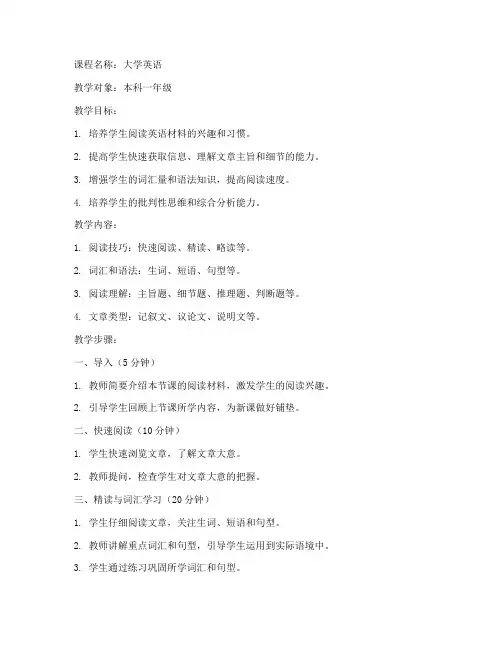
课程名称:大学英语教学对象:本科一年级教学目标:1. 培养学生阅读英语材料的兴趣和习惯。
2. 提高学生快速获取信息、理解文章主旨和细节的能力。
3. 增强学生的词汇量和语法知识,提高阅读速度。
4. 培养学生的批判性思维和综合分析能力。
教学内容:1. 阅读技巧:快速阅读、精读、略读等。
2. 词汇和语法:生词、短语、句型等。
3. 阅读理解:主旨题、细节题、推理题、判断题等。
4. 文章类型:记叙文、议论文、说明文等。
教学步骤:一、导入(5分钟)1. 教师简要介绍本节课的阅读材料,激发学生的阅读兴趣。
2. 引导学生回顾上节课所学内容,为新课做好铺垫。
二、快速阅读(10分钟)1. 学生快速浏览文章,了解文章大意。
2. 教师提问,检查学生对文章大意的把握。
三、精读与词汇学习(20分钟)1. 学生仔细阅读文章,关注生词、短语和句型。
2. 教师讲解重点词汇和句型,引导学生运用到实际语境中。
3. 学生通过练习巩固所学词汇和句型。
四、阅读理解(15分钟)1. 学生完成阅读理解练习,教师讲解答案和解析。
2. 学生分享自己的解题思路,互相学习。
五、讨论与总结(10分钟)1. 学生分组讨论文章主题,发表自己的观点。
2. 教师总结本节课的重点内容,强调阅读技巧的重要性。
教学手段:1. 多媒体课件:展示文章、词汇、语法等内容。
2. 课堂练习:提高学生的阅读能力和解题技巧。
3. 小组讨论:培养学生的团队合作意识和表达能力。
教学评价:1. 课堂参与度:观察学生在课堂上的表现,如发言、提问等。
2. 阅读理解练习:检查学生对文章的理解程度。
3. 课后作业:巩固所学内容,提高学生的自主学习能力。
教学反思:1. 教师根据学生的实际情况调整教学策略,提高教学效果。
2. 注重培养学生的阅读兴趣和习惯,提高学生的阅读能力。
3. 关注学生的个体差异,关注学生的阅读需求,为每个学生提供合适的阅读材料。
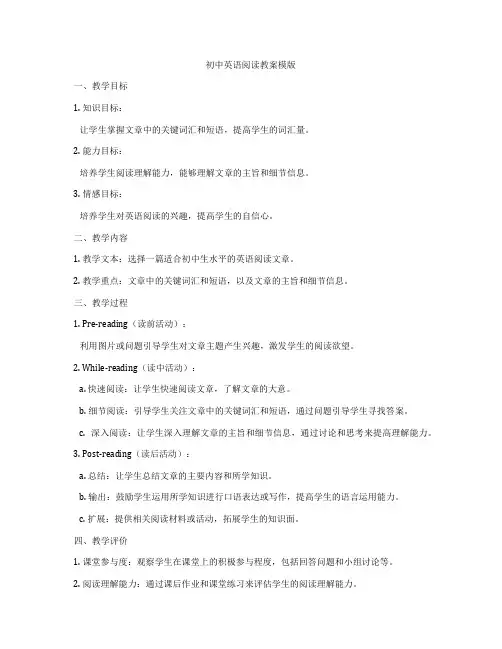
初中英语阅读教案模版一、教学目标1. 知识目标:让学生掌握文章中的关键词汇和短语,提高学生的词汇量。
2. 能力目标:培养学生阅读理解能力,能够理解文章的主旨和细节信息。
3. 情感目标:培养学生对英语阅读的兴趣,提高学生的自信心。
二、教学内容1. 教学文本:选择一篇适合初中生水平的英语阅读文章。
2. 教学重点:文章中的关键词汇和短语,以及文章的主旨和细节信息。
三、教学过程1. Pre-reading(读前活动):利用图片或问题引导学生对文章主题产生兴趣,激发学生的阅读欲望。
2. While-reading(读中活动):a. 快速阅读:让学生快速阅读文章,了解文章的大意。
b. 细节阅读:引导学生关注文章中的关键词汇和短语,通过问题引导学生寻找答案。
c. 深入阅读:让学生深入理解文章的主旨和细节信息,通过讨论和思考来提高理解能力。
3. Post-reading(读后活动):a. 总结:让学生总结文章的主要内容和所学知识。
b. 输出:鼓励学生运用所学知识进行口语表达或写作,提高学生的语言运用能力。
c. 扩展:提供相关阅读材料或活动,拓展学生的知识面。
四、教学评价1. 课堂参与度:观察学生在课堂上的积极参与程度,包括回答问题和小组讨论等。
2. 阅读理解能力:通过课后作业和课堂练习来评估学生的阅读理解能力。
3. 情感态度:观察学生对英语阅读的态度和自信心,鼓励积极正面的反馈。
五、教学资源1. 教学文章:选择一篇适合初中生水平的英语阅读文章。
2. 图片或多媒体资源:用于引导学生对文章主题产生兴趣。
3. 学习任务单:用于指导学生的学习活动。
六、教学步骤1. 引入:利用图片或问题引导学生对文章主题产生兴趣。
2. 快速阅读:让学生快速阅读文章,了解文章的大意。
3. 细节阅读:引导学生关注文章中的关键词汇和短语,通过问题引导学生寻找答案。
4. 深入阅读:让学生深入理解文章的主旨和细节信息,通过讨论和思考来提高理解能力。
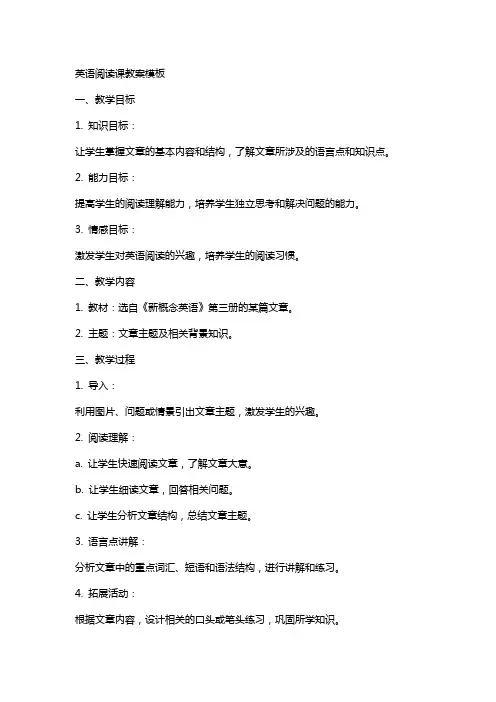
英语阅读课教案模板一、教学目标1. 知识目标:让学生掌握文章的基本内容和结构,了解文章所涉及的语言点和知识点。
2. 能力目标:提高学生的阅读理解能力,培养学生独立思考和解决问题的能力。
3. 情感目标:激发学生对英语阅读的兴趣,培养学生的阅读习惯。
二、教学内容1. 教材:选自《新概念英语》第三册的某篇文章。
2. 主题:文章主题及相关背景知识。
三、教学过程1. 导入:利用图片、问题或情景引出文章主题,激发学生的兴趣。
2. 阅读理解:a. 让学生快速阅读文章,了解文章大意。
b. 让学生细读文章,回答相关问题。
c. 让学生分析文章结构,总结文章主题。
3. 语言点讲解:分析文章中的重点词汇、短语和语法结构,进行讲解和练习。
4. 拓展活动:根据文章内容,设计相关的口头或笔头练习,巩固所学知识。
5. 总结:对本节课的内容进行回顾和总结,强调重点和难点。
四、教学评价1. 课堂参与度:观察学生在课堂上的活跃程度和参与情况。
2. 阅读理解测试:通过课后作业或课堂测试,评估学生的阅读理解能力。
3. 语言点掌握:检查学生在练习中的语言运用情况,判断其对文章语言点的掌握程度。
五、教学资源1. 教材:《新概念英语》第三册。
2. 辅助材料:相关图片、PPT、练习册等。
3. 教学工具:黑板、投影仪、计算机等。
六、教学步骤1. 课前准备:提前布置学生预习文章,了解文章主题和大意。
2. 课堂导入:通过提问或讨论,引导学生回顾预习内容,为新课做铺垫。
3. 快速阅读:要求学生在规定时间内快速阅读文章,掌握文章大意。
4. 细节理解:让学生细读文章,回答针对文章细节的问题,检验学生的理解程度。
5. 词汇学习:针对文章中的生词和短语,进行讲解和练习,帮助学生掌握。
6. 语法讲解:分析文章中的语法结构,进行讲解和练习,提高学生的语法水平。
7. 小组讨论:将学生分成小组,讨论文章中的某个问题或观点,培养学生的合作和交流能力。
8. 课堂小结:对本节课的内容进行回顾和总结,强调重点和难点。
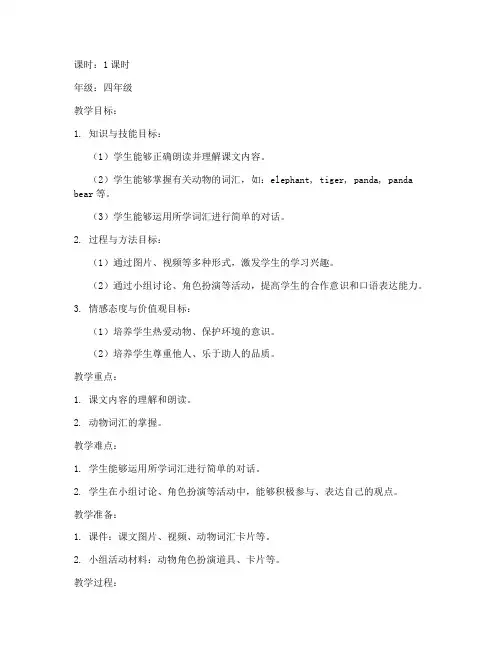
课时:1课时年级:四年级教学目标:1. 知识与技能目标:(1)学生能够正确朗读并理解课文内容。
(2)学生能够掌握有关动物的词汇,如:elephant, tiger, panda, panda bear等。
(3)学生能够运用所学词汇进行简单的对话。
2. 过程与方法目标:(1)通过图片、视频等多种形式,激发学生的学习兴趣。
(2)通过小组讨论、角色扮演等活动,提高学生的合作意识和口语表达能力。
3. 情感态度与价值观目标:(1)培养学生热爱动物、保护环境的意识。
(2)培养学生尊重他人、乐于助人的品质。
教学重点:1. 课文内容的理解和朗读。
2. 动物词汇的掌握。
教学难点:1. 学生能够运用所学词汇进行简单的对话。
2. 学生在小组讨论、角色扮演等活动中,能够积极参与、表达自己的观点。
教学准备:1. 课件:课文图片、视频、动物词汇卡片等。
2. 小组活动材料:动物角色扮演道具、卡片等。
教学过程:一、导入1. 教师展示一张可爱的动物图片,引导学生说出图片中的动物名称。
2. 引导学生讨论自己最喜欢的动物,并简单说明原因。
二、新课导入1. 教师播放一段关于动物的短视频,激发学生的学习兴趣。
2. 学生跟随教师一起朗读课文,注意语音、语调。
三、课文学习1. 教师带领学生逐句朗读课文,并解释重点词汇和句型。
2. 学生跟读课文,巩固所学知识。
四、词汇学习1. 教师展示动物词汇卡片,引导学生认读和拼写。
2. 学生分组进行词汇接龙游戏,巩固所学词汇。
五、小组活动1. 教师将学生分成若干小组,每组选出一个动物角色。
2. 小组成员根据所学内容,编写一段关于自己角色的对话。
3. 各小组进行角色扮演,其他学生观看并评价。
六、课堂小结1. 教师总结本节课所学内容,强调重点词汇和句型。
2. 学生分享自己在小组活动中的收获。
七、作业布置1. 课后复习课文,熟读课文内容。
2. 家长协助学生完成以下作业:(1)画一幅自己最喜欢的动物画。
(2)写一篇关于自己最喜欢的动物的短文。
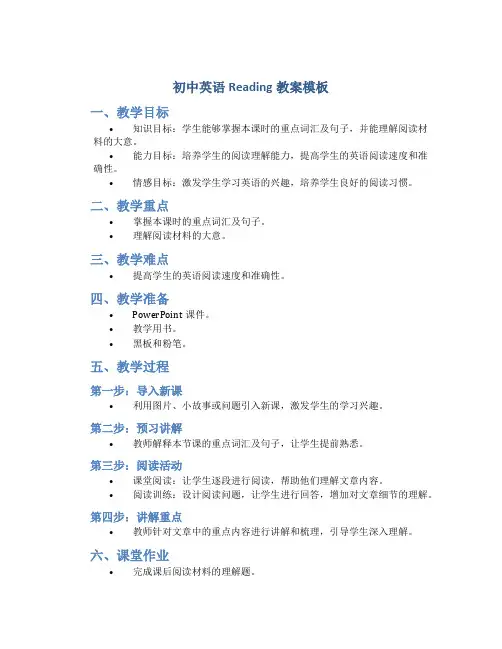
初中英语Reading教案模板
一、教学目标
•知识目标:学生能够掌握本课时的重点词汇及句子,并能理解阅读材料的大意。
•能力目标:培养学生的阅读理解能力,提高学生的英语阅读速度和准确性。
•情感目标:激发学生学习英语的兴趣,培养学生良好的阅读习惯。
二、教学重点
•掌握本课时的重点词汇及句子。
•理解阅读材料的大意。
三、教学难点
•提高学生的英语阅读速度和准确性。
四、教学准备
•PowerPoint课件。
•教学用书。
•黑板和粉笔。
五、教学过程
第一步:导入新课
•利用图片、小故事或问题引入新课,激发学生的学习兴趣。
第二步:预习讲解
•教师解释本节课的重点词汇及句子,让学生提前熟悉。
第三步:阅读活动
•课堂阅读:让学生逐段进行阅读,帮助他们理解文章内容。
•阅读训练:设计阅读问题,让学生进行回答,增加对文章细节的理解。
第四步:讲解重点
•教师针对文章中的重点内容进行讲解和梳理,引导学生深入理解。
六、课堂作业
•完成课后阅读材料的理解题。
•背诵本节课的重点句子。
七、板书设计
•重点词汇及句子。
•本节课的主要内容概括。
八、教学反思
•教学中学生的反应如何?
•教学难点是否顺利解决?
•下节课如何进行针对性调整?
以上教案模板为初中英语Reading课程设计,旨在帮助学生提高阅读理解能力,欢迎教师根据实际情况进行灵活调整与拓展。
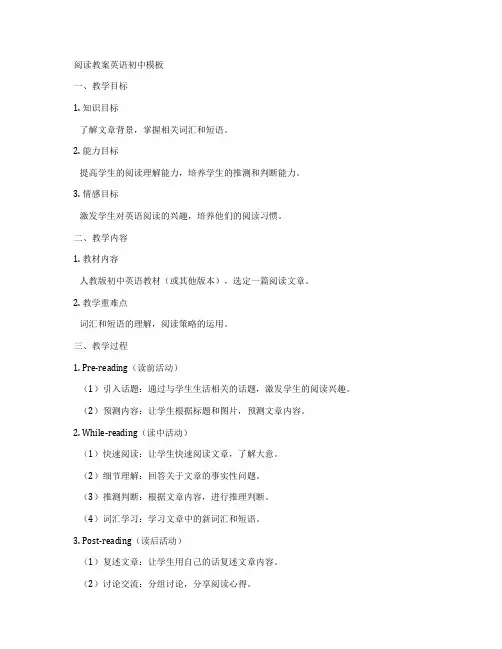
阅读教案英语初中模板一、教学目标1. 知识目标了解文章背景,掌握相关词汇和短语。
2. 能力目标提高学生的阅读理解能力,培养学生的推测和判断能力。
3. 情感目标激发学生对英语阅读的兴趣,培养他们的阅读习惯。
二、教学内容1. 教材内容人教版初中英语教材(或其他版本),选定一篇阅读文章。
2. 教学重难点词汇和短语的理解,阅读策略的运用。
三、教学过程1. Pre-reading(读前活动)(1)引入话题:通过与学生生活相关的话题,激发学生的阅读兴趣。
(2)预测内容:让学生根据标题和图片,预测文章内容。
2. While-reading(读中活动)(1)快速阅读:让学生快速阅读文章,了解大意。
(2)细节理解:回答关于文章的事实性问题。
(3)推测判断:根据文章内容,进行推理判断。
(4)词汇学习:学习文章中的新词汇和短语。
3. Post-reading(读后活动)(1)复述文章:让学生用自己的话复述文章内容。
(2)讨论交流:分组讨论,分享阅读心得。
(3)拓展活动:根据文章内容,设计相关拓展活动。
四、教学评价1. 课堂表现:观察学生在课堂上的参与程度,积极主动性。
2. 阅读理解:通过回答问题,检查学生的阅读理解能力。
3. 拓展活动:评估学生在拓展活动中的表现,检验他们的综合运用能力。
五、教学反思课后,教师应认真反思教学效果,针对学生的掌握情况,调整教学策略,以提高教学效果。
以上是一份英语初中阅读教案的模板,具体内容需要根据所选文章和学生的实际情况进行调整。
希望对您的教学有所帮助。
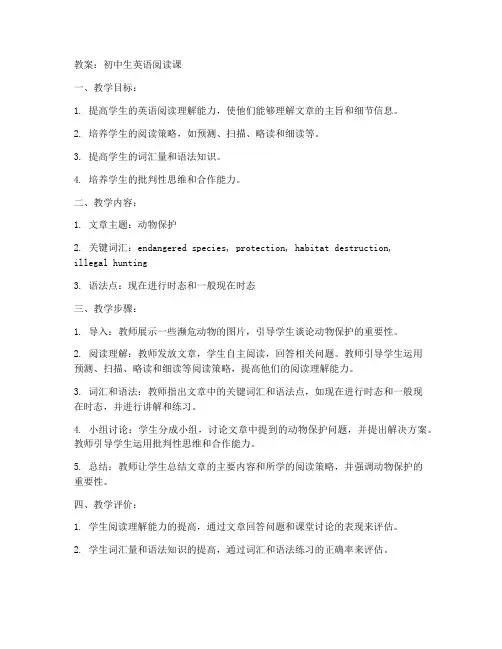
教案:初中生英语阅读课一、教学目标:1. 提高学生的英语阅读理解能力,使他们能够理解文章的主旨和细节信息。
2. 培养学生的阅读策略,如预测、扫描、略读和细读等。
3. 提高学生的词汇量和语法知识。
4. 培养学生的批判性思维和合作能力。
二、教学内容:1. 文章主题:动物保护2. 关键词汇:endangered species, protection, habitat destruction,illegal hunting3. 语法点:现在进行时态和一般现在时态三、教学步骤:1. 导入:教师展示一些濒危动物的图片,引导学生谈论动物保护的重要性。
2. 阅读理解:教师发放文章,学生自主阅读,回答相关问题。
教师引导学生运用预测、扫描、略读和细读等阅读策略,提高他们的阅读理解能力。
3. 词汇和语法:教师指出文章中的关键词汇和语法点,如现在进行时态和一般现在时态,并进行讲解和练习。
4. 小组讨论:学生分成小组,讨论文章中提到的动物保护问题,并提出解决方案。
教师引导学生运用批判性思维和合作能力。
5. 总结:教师让学生总结文章的主要内容和所学的阅读策略,并强调动物保护的重要性。
四、教学评价:1. 学生阅读理解能力的提高,通过文章回答问题和课堂讨论的表现来评估。
2. 学生词汇量和语法知识的提高,通过词汇和语法练习的正确率来评估。
3. 学生批判性思维和合作能力的提高,通过小组讨论的表现和提出的解决方案来评估。
五、教学资源:1. 文章:关于动物保护的英文文章。
2. 图片:濒危动物的图片。
3. 词汇和语法练习:相关的练习题。
六、教学时间:1课时(40分钟)七、教学建议:1. 在课堂上鼓励学生积极参与,提高他们的自信心和兴趣。
2. 针对不同学生的水平,可以适当调整教学内容和难度。
3. 鼓励学生在课后进行自主阅读,扩大词汇量和提高阅读能力。
4. 注重培养学生的批判性思维和合作能力,提高他们的综合素养。
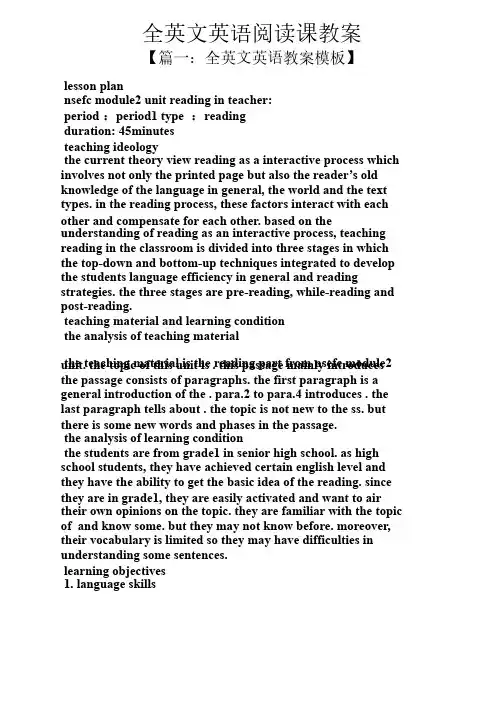
全英文英语阅读课教案【篇一:全英文英语教案模板】lesson plannsefc module2 unit reading in teacher:period:period1 type:readingduration: 45minutesteaching ideologythe current theory view reading as a interactive process which involves not only the printed page but also the reader’s old knowledge of the language in general, the world and the text types. in the reading process, these factors interact with each other and compensate for each other. based on the understanding of reading as an interactive process, teaching reading in the classroom is divided into three stages in which the top-down and bottom-up techniques integrated to develop the students language efficiency in general and reading strategies. the three stages are pre-reading, while-reading and post-reading.teaching material and learning conditionthe analysis of teaching materialthe teaching material is the reading part from nsefc module2 unit. the topic of this unit is . this passage mainly introduces the passage consists of paragraphs. the first paragraph is a general introduction of the . para.2 to para.4 introduces . the last paragraph tells about . the topic is not new to the ss. but there is some new words and phases in the passage.the analysis of learning conditionthe students are from grade1 in senior high school. as high school students, they have achieved certain english level and they have the ability to get the basic idea of the reading. since they are in grade1, they are easily activated and want to air their own opinions on the topic. they are familiar with the topic of and know some. but they may not know before. moreover, their vocabulary is limited so they may have difficulties in understanding some sentences.learning objectives1. language skillsat the beginning of the class, ss can predict the content ofthe passage based on the title. ? ss can scan the passage andfind out the specific information such as the person relatedwithss can summarize the passage with the help of the clues ofthe passage.2. language knowledgess can master the key words and phrases of the passage as follows, . ? ss can learn , especially3. affectsss will realize that and they will concern themselves with the issue of4. cultural awarenessss will broaden their minds by knowing something about 5. learning strategiesss will cultivate their ability individual learning and cooperative learning by doing someactivities independently and some in groups.ss will communicate with each other in english while doingthe group work.language difficultiesfocuses and anticipatedlanguage focusesthis is a reading period so the focus is to cultivate thestudents’ reading skills. the many activities are designed tohelp ss to train their reading skills, such as predicting, skimming, scanning and summarizing.it is also important for the ss to master the new words and phrases.anticipated difficultiesas the ss have a limited vocabulary, so they may have some difficulties in understanding the passage. so the teacher willhelp them learn the new words and phrases.ss may did not heard before, so the teacher will tell themsome background knowledge about it.teaching methodthree-stage model: based on the understanding of reading asan interactive process, teaching reading in the classroom is divided into three stages in which the top-down and bottom-up techniques integrated to develop the students languageefficiency in general and reading strategies. the three stagesare pre-reading, while-reading and post-reading.teaching aidsmultimedia devices and ppt documents: in order to help ss tofully understand the whole passage, i adopt multimediadevices and ppt documents to bring the real-life situation intothe classroom.teaching proceduresstep1. lead-in (6min)activity1. greetings and free-talking (2min)t leads into the topic by asking ss some they know. ss tell the name of the they know freely.t: hello boys and girls. (ss say hello to the teacher.)t: when we say , what appears in your minds? (ss tell thethings appear in their minds freely.) t: what are the ? (ss tell some names of .)activity2. picture-talking (4min)t shows some pictures about the in china and abroad. after seeing the pictures, ss are expected to tell the similarities of them.t: just now, you talk about some in china. now, let’s see some pictures of some . (t shows the pictures and ss see them carefully.)t: what do the have in common?for example, they are very precious. what are your opinions?(t gives them some hints and ss tell the characteristics of ) [aims]in this step, t first leads in the topic by talking with the ssfreely about the whichis familiar to them and then ss see some pictures and tell the characteristics. these two activities aim to arouse the ss’interests in the topic and activate their old knowledge of . thenss will be mentally prepared for the reading comprehension. what’s more,when they are talking about the charateristics of, they will realize that theare rare and precious and they will concern themselves with the issue of .step2. pre-reading (3min)activity1. knowing something about (1min)t gives a brief introduction of the. ss will know the t: today, weare going to learn . it is . do you know what is? (t shows some pictures ofand ss get to know the .)activity2. predicting (2min)t asks ss to read the title of the passage and then ask themsome questions. ss will predict the content of the passage withthe help of the title.t: please look at the title “”, what does “” mean?(if the ss can not give the answer, then t explain it.)t: in search means that people are looking for it. why arepeople looking for it? can you guess? what will the passagetalk about?(ss predict the content, but t will not give the answer here.)[aims]in this step, the ss first know some information of the ; the background information will make it easier for the ss tounderstand the passage. then t asks ss to make predictionsabout the passage. it aims to help ss develop the reading skillsof predicting.step3. while-reading (22min)activity1. skimming (4min)ss skim the whole passage and find out and check their predictions. t: why are people still ? here is a multiple choicefor you.activity2. scanning (3min)t presents several true or false statements and asks the ss toscan the passage and judge the right from the wrong.(keys: F,F,T,T,F)activity3 close-reading (15min)t designs various kinds of activities and ss do the activities tofully understand the passage. para.1t: please read para.1 carefully and then take some note aboutthe .para.2-4please read para.2-4 carefully and then find out the removal ofthe room.please read para.2-4 carefully and then find out the personrelated with the amber room and the things them down with it. para.5please read para.5 carefully and then find out the therebuilding of the amber room.【篇二:初中英语阅读课教学设计】谈初中英语阅读课教学案例吉林省桦甸市金沙中学:王欣平一、背景现行初中英语教材具有很多的优点,但由于学生认知水平的发展具有规律性,教师只有充分认识和掌握这种规律,并结合教学实际,合理设计教学程序,充分发挥学生的主体作用,教学相长,才能达到教学效果的最优化。
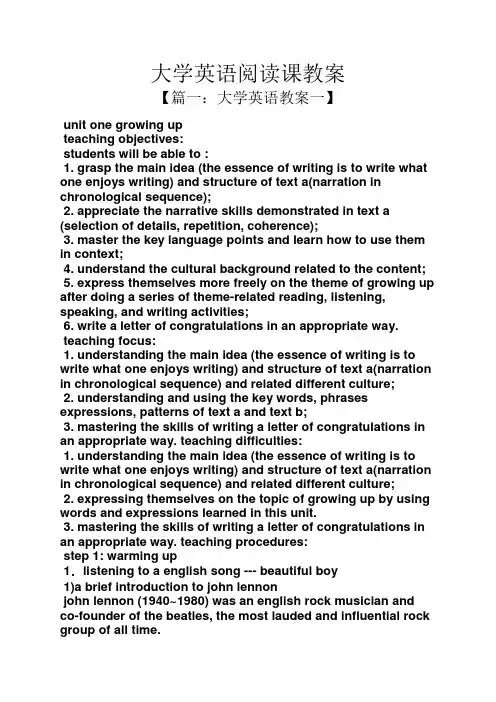
大学英语阅读课教案【篇一:大学英语教案一】unit one growing upteaching objectives:students will be able to :1. grasp the main idea (the essence of writing is to write what one enjoys writing) and structure of text a(narration in chronological sequence);2. appreciate the narrative skills demonstrated in text a (selection of details, repetition, coherence);3. master the key language points and learn how to use them in context;4. understand the cultural background related to the content;5. express themselves more freely on the theme of growing up after doing a series of theme-related reading, listening, speaking, and writing activities;6. write a letter of congratulations in an appropriate way.teaching focus:1. understanding the main idea (the essence of writing is to write what one enjoys writing) and structure of text a(narration in chronological sequence) and related different culture;2. understanding and using the key words, phrases expressions, patterns of text a and text b;3. mastering the skills of writing a letter of congratulations in an appropriate way. teaching difficulties:1. understanding the main idea (the essence of writing is to write what one enjoys writing) and structure of text a(narration in chronological sequence) and related different culture;2. expressing themselves on the topic of growing up by using words and expressions learned in this unit.3. mastering the skills of writing a letter of congratulations in an appropriate way. teaching procedures:step 1: warming up1.listening to a english song --- beautiful boy1)a brief introduction to john lennonjohn lennon (1940~1980) was an english rock musician andco-founder of the beatles, the most lauded and influential rock group of all time.2) listening to the english song--- beautiful boy3) ss finish after-listening practice on page34) questions about the song and the textsa. in your opinion, what is the song beautiful boy going to tell us?b. what does lennon think of growing up? is it easy or full of adventures?c. can you guess what the texts in this unit are going to be about?2. background information1) spaghettidefinition:spaghetti is the italian-style thin noodle, cooked by boiling and served with sauce. unlike some chinese noodles, it is not served in soup and will never taste pulpy (软乎乎、没有嚼劲的). listen and practice:read the words given below and then listen to the passage. after listening to the passage, one student is required to come up and show the right way of eating spaghetti before the class. the right way of eating spaghetti 1. hold the fork in your hand as if to poke the spaghetti. 2. scoop up a small amount of spaghetti on your fork and raise it about 30cm above your plate. 3. make sure the spaghetti on your fork is completely disconnected from the remainder on your plate.4. put the prongs of the fork at an edge of the plate that is free of food.5. quickly point the prongs of the fork straight down toward the plate and place the points onthe plate.6. twirl the fork to gather the spaghetti around the prongs.7. with a quick scooping movement, gather up the roll around the prongs and place it in yourmouth.8. gently gather up any stray spaghetti ends that don’t make it all the way into your mouth.2) the american educational systemin the united states, education is the responsibility of individual states, not of the federal government, so requirements may vary from one state to another. the following is a generalization:kindergarten: under 5 years oldelementary / primary school (grades 1~6): 6~11 yearsjunior high / middle school (grades 7~8): 12~13 yearssenior / high school (grades 9~12): 14~17 years oldcollege, institute, academy (学院), university3. explanation of the title of text ahave ss read the title of text a and find out in which paragraph a similar phrase appears (para.5). ask ss to explain in their own words what the author’s mean by ―write for myself‖. step 2: global analysis of text a1. scanningss scan text a and find out all the time words, phrases and clauses.since my childhood in belleville (para. 1)until my third year in high school (para. 1)until then (para. 1)when our class was assigned to mr. fleagle for third-year english (para. 2)late in the year (para. 3)until the night before the essay was due (para. 3)when i finished (para. 6)next morning (para. 6)two days passed (para. 6)when i saw him lift my paper from his desk ... (para. 6) when mr. fleagle finished (para. 9)2. part division of the textpart 1(paras 1-2) baker was bored by everything associated with english courses, including his new english teacher.part 2(paras 3-5)baker found himself attracted by one particular topic and wrote about it for his own enjoyment.part 3(paras 6-9)the experience of writing the essay helped baker discover his talent for writing and realize what he wished to do in life.3. further understanding1) exercise: true or falsea. baker had never thought of becoming a writer until he was in the eleventh grade. (f)b. teachers found it painful to read students’ long and lifeless essays. (t)c. before mr. fleagle became the english teacher for baker’s class, the english course had been interesting. (f)d. in baker’s opinion, mr. fleagle was really a formal, rigid and out-of-date teacher only because of fleagle’s manner of speaking. (f)2) exercise: multiple choice (all the exercises in teaching ppt)3) questions related to text a:ss answer the following questions orally and brieflya. do you think baker would write another essay if he had enough time? why?b. what was baker prepared for when he found all the papers had been given back but his?c. whose essay did mr. fleagle read to the class? how did the class respond?d. which paragraph in this part gives readers the impression that baker’s essay was very good?e. why did baker feel so delighted?step 3: language / culture study and practice1. explain language points and have ss practice themdifficult sentences1)2) paraphrase the sentence.(i found it painful to write long, boring essays as required by teachers; neither did teachers enjoy what i wrote.)3) what can we learn from this phrase?(we can know from this phrase that before mr. fleagle became baker’s english teacher, all english courses were dull.)4)what does the author really mean when he says ―i ... was not disappointed‖?(he means that his expectation was right that mr. fleag le’s lessons were dull.)5) 1) what can we infer from these sentences?(baker was unwilling to write his essay.)2) list phrases to support your inference.(did nothing until … the essay was due; faced up to the unwelcome task.)6) paraphrase the sentence and translate it into chinese.(at the sight of the title i saw an unusual series of pictures in my mind’s eye. 这个题目在我脑海里唤起了一连串不同寻常的图像。
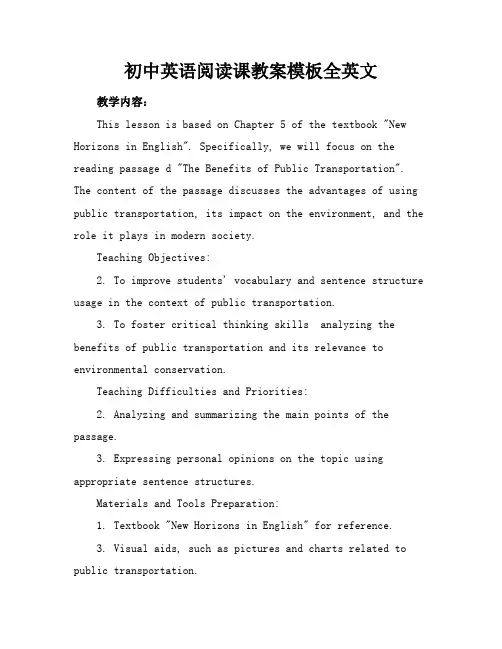
初中英语阅读课教案模板全英文教学内容:This lesson is based on Chapter 5 of the textbook "New Horizons in English". Specifically, we will focus on the reading passage d "The Benefits of Public Transportation". The content of the passage discusses the advantages of using public transportation, its impact on the environment, and the role it plays in modern society.Teaching Objectives:2. To improve students' vocabulary and sentence structure usage in the context of public transportation.3. To foster critical thinking skills analyzing the benefits of public transportation and its relevance to environmental conservation.Teaching Difficulties and Priorities:2. Analyzing and summarizing the main points of the passage.3. Expressing personal opinions on the topic using appropriate sentence structures.Materials and Tools Preparation:1. Textbook "New Horizons in English" for reference.3. Visual aids, such as pictures and charts related to public transportation.4. Whiteboard and markers for the teacher.Teaching Process:1. Introduction (5 minutes):Engage students with a practical scenario: Discuss a recent experience of using public transportation.Ask students to share their opinions on the advantages and disadvantages of public transportation.2. Reading Passage (15 minutes):Ask students to read the passage silently and underline key points.3. Vocabulary and Grammar Focus (15 minutes):Present and discuss new vocabulary related to public transportation.Provide examples and practice exercises for sentence structures used in the passage.4. Comprehension Questions and Discussion (15 minutes):Encourage students to provide evidence from the passage to support their answers.5. Group Activity (15 minutes):Divide students into groups and assign each group a specific aspect of public transportation to research.Each group will create a brief presentation to share their findings with the class.6. Presentation and Class Discussion (10 minutes):Each group will present their findings, followed a class discussion on the benefits of public transportation.Encourage students to express their opinions and provide examples.7. Summary and Key Points Review (5 minutes):Recap the main points of the passage and the vocabulary learned.Address any remaining questions or concerns from the students.Board Design:1. Title: "The Benefits of Public Transportation"2. Main ideas and key points of the passage.3. New vocabulary with definitions and example sentences.4. Important sentence structures used in the passage.Homework Design:1. Comprehension Questions:a. What are the main benefits of public transportation mentioned in the passage?b. How does public transportation contribute to environmental conservation?c. Explain the importance of public transportation in modern society.Answers will be provided in the next class.2. Creative Writing:Write a short paragraph expressing your opinion on the benefits of public transportation. Use at least three new vocabulary words and two sentence structures learned in class.Postlesson Reflection and Extension:1. Reflect on the effectiveness of the teaching methods used, including practical scenario introduction and group activities.3. Plan for future lessons incorporating moreinteractive activities and reallife examples to enhance understanding.4. Provide additional resources and extension activities for students who require further practice or wish to explore the topic in more depth.重点和难点解析:1. 教学难点与重点的识别。
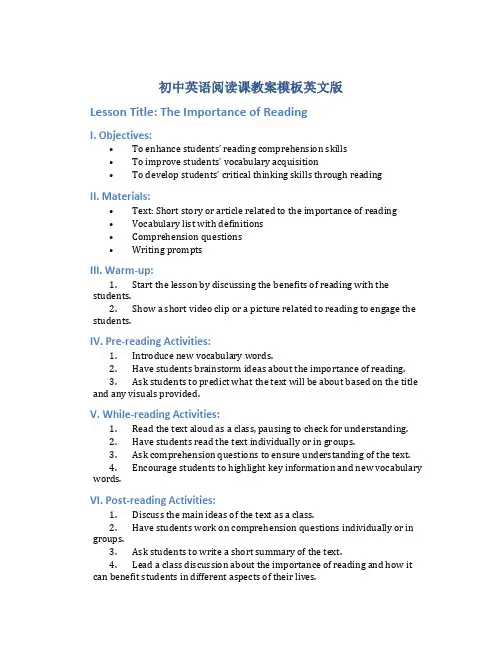
初中英语阅读课教案模板英文版Lesson Title: The Importance of ReadingI. Objectives:•To enhance students’ reading comprehension skills•To improve students’ vocabulary acquisition•To develop students’ critical thinking skills through readingII. Materials:•Text: Short story or article related to the importance of reading•Vocabulary list with definitions•Comprehension questions•Writing promptsIII. Warm-up:1.Start the lesson by discussing the benefits of reading with the students.2.Show a short video clip or a picture related to reading to engage the students.IV. Pre-reading Activities:1.Introduce new vocabulary words.2.Have students brainstorm ideas about the importance of reading.3.Ask students to predict what the text will be about based on the title and any visuals provided.V. While-reading Activities:1.Read the text aloud as a class, pausing to check for understanding.2.Have students read the text individually or in groups.3.Ask comprehension questions to ensure understanding of the text.4.Encourage students to highlight key information and new vocabulary words.VI. Post-reading Activities:1.Discuss the main ideas of the text as a class.2.Have students work on comprehension questions individually or in groups.3.Ask students to write a short summary of the text.4.Lead a class discussion about the importance of reading and how it can benefit students in different aspects of their lives.VII. Extension Activities:1.Have students research and present on a famous author or book.2.Encourage students to write a reflective piece about their ownreading habits and goals.anize a book club where students can read and discuss a booktogether.VIII. Assessment:•Assess students based on their participation in class discussions, comprehension of the text, and completion of post-reading activities.IX. Homework:•Assign reading passages or articles for homework and ask students to write a response or summary.X. Closure:•Review the key points of the lesson and emphasize the importance of reading in students’ live s.This lesson plan aims to engage students in meaningful reading activities that will enhance their language skills and critical thinking abilities. By exploring the theme of the importance of reading, students will not only improve their English proficiency but also develop a lifelong love for reading.。
小学英文阅读指导教案模板一、教学目标本教案旨在帮助小学生提高英文阅读能力,培养他们的阅读理解和语言表达能力。
二、教学内容本课程将选择适合小学生的英文阅读材料,包括简单的故事、诗歌或短文。
通过阅读这些材料,学生将学习基本的词汇、语法结构和阅读技巧。
三、教学步骤1. 导入通过引入一个有趣的问题或故事情节引起学生的兴趣,并激发他们对英文阅读的兴趣。
2. 预习教师在课前将阅读材料分发给学生,让他们提前阅读。
学生可以标记不熟悉的单词或句子。
3. 阅读学生在课堂上朗读阅读材料,并尝试理解其中的内容。
教师可以提供适当的指导,帮助学生理解文章的主旨和细节。
4. 讨论教师与学生一起讨论阅读材料中的问题和观点。
学生可以分享自己的理解和观点,并与同学进行互动交流。
5. 语言拓展教师可以引导学生学习新的词汇和语法结构,以丰富他们的语言表达能力。
6. 写作练习学生可以根据阅读材料进行写作练习,包括写一篇文章、写一封信或进行简短的写作任务。
7. 总结教师与学生一起总结本节课的学习内容,并鼓励学生继续阅读和学习英文。
四、教学评估教师可以通过观察学生的阅读表现、听取学生的观点和评估学生的写作作品来评估他们的英文阅读能力。
五、教学资源教师准备合适的英文阅读材料、课堂讲义、词汇表等资源,以支持学生的学习。
六、教学延伸教师可以鼓励学生在课后继续阅读英文材料,并提供相关的阅读推荐和学习资源。
七、教学反思教师应及时反思教学过程,总结教学经验,并根据学生的实际情况进行相应的调整和改进。
以上为小学英文阅读指导教案模板,根据实际教学情况和学生的需求,可以适当调整和修改。
希望能对您的教学工作有所帮助!。
初中英语阅读教学设计教案模板教案概述:本教案旨在帮助初中英语教师设计一堂有效的阅读教学课程。
通过此教案,学生将学习阅读技巧,提高阅读理解能力,并在实际阅读中获得乐趣。
教学目标:1. 学生能够通过阅读理解短文,并回答相关问题。
2. 学生能够运用阅读策略提高阅读效率。
3. 学生能够获得阅读的乐趣,并培养持续阅读的兴趣。
教学准备:1. 短文或阅读材料: 这里可以自行选择适合学生年龄和英语水平的阅读材料。
2. 学生练习题:准备与所选阅读材料相关的问题,以便学生进行阅读理解训练。
教学过程:引入:1. 引入学生对于阅读的兴趣,可以通过提问、展示图片或视频等方式激发学生的学习兴趣。
2. 引入学生对于本次阅读材料的背景知识,帮助学生更好地理解并联系到实际生活。
主体:1. 预读活动: 提供一些与阅读材料相关的问题,引导学生在阅读前思考,并激发他们对于文本内容的好奇心。
2. 阅读活动:a. 学生独立阅读: 学生在课堂上或在家中独自阅读所选材料,并尽可能回答相关问题。
b. 讨论和分享: 学生之间或与教师进行讨论,分享他们对于文本的理解和答案。
c. 教师指导: 教师给予学生相关阅读技巧和策略,如扫读、略读、划重点等,并解答学生的疑问。
3. 后读活动:a. 检查答案: 教师核对学生的答案,并给予相关反馈。
b. 扩展阅读: 提供额外的阅读材料,帮助学生进一步拓展阅读能力和知识面。
c. 反思总结: 引导学生回顾整个阅读过程,总结学到的阅读技巧和策略。
延伸活动:1. 课外阅读推荐: 教师可以推荐一些适合学生年龄和英语水平的课外阅读材料,鼓励学生继续进行阅读训练。
2. 阅读分享: 学生可以在课堂上或班级活动中,分享他们阅读过的书籍和感想,激发课堂阅读氛围。
教学评价:1. 教师可根据学生的回答和表现,评价他们的阅读理解能力以及对于阅读技巧的掌握程度。
2. 学生可以通过回答问题、参与讨论和展示等方式,展示他们的阅读成果和收获。
3. 教师也可以设计一些作业或考试,对学生的阅读能力和技巧进行综合评价。
教资英语阅读教学设计范文近年来,随着教育改革的不断推进,英语教育越来越重视培养学生的阅读能力。
英语阅读教学是培养学生综合语言运用能力的重要环节。
本文将介绍一种教资英语阅读教学的设计范文,帮助教师更好地实施阅读教学。
一、教学目标通过本节课的教学,学生应能够:1. 熟练掌握阅读理解的基本技巧和答题方法;2. 有效运用英语阅读技巧提高阅读质量和速度;3. 培养学生积极主动的阅读习惯。
二、教学内容本节课的教学内容主要包括:1. 阅读理解技巧的讲解和练习;2. 扩展阅读材料的选择和分析;3. 提高学生阅读速度的训练。
三、教学过程1. 导入环节在引入阅读材料之前,教师可通过展示一张图片或提问的方式引发学生对主题的兴趣,激发他们的思考。
2. 阅读技巧讲解和练习教师通过讲解阅读技巧,如浏览式阅读、扫读和细读等,帮助学生了解不同的阅读目的和方法。
然后,教师可选择一篇适合学生水平的文章进行阅读训练,并引导学生根据问题或任务选择相应的阅读策略进行阅读理解。
3. 扩展阅读材料选择和分析教师提供更多的阅读材料供学生选择,并根据学生的兴趣和实际情况进行指导。
教师在此过程中应培养学生对阅读材料的分析能力,如主题、段落结构和关键词的识别等。
4. 提高阅读速度的训练为提高学生的阅读速度,教师可采用一些阅读训练的活动,如速读和词汇快速辨认等。
同时,教师还应鼓励学生多读英文原著或英文报刊,以提高他们的阅读效率和水平。
四、教学评价教师应根据学生的阅读理解能力、阅读速度以及对阅读材料的分析和运用能力进行评价。
评价可以包括课堂测验、小组合作活动和口头表达等多种形式。
五、板书设计教师可在板书上呈现本节课的主要内容,如阅读技巧、扩展阅读材料和提高阅读速度的训练方法等。
板书内容应简洁明了,方便学生复习和回顾。
六、教学反思教师在设计教育阅读教学时应注重学生的主体性,激发他们的兴趣和积极性,培养学生独立思考和解决问题的能力。
教师还应关注学生的实际需求,根据学生的差异性制定不同的教学策略和辅导计划,帮助他们取得更好的阅读成效。
小学英语阅读课教案模板一等奖教案标题:小学英语阅读课教案模板一等奖教案目标:1. 帮助学生提高英语阅读理解能力。
2. 培养学生对英语阅读的兴趣和积极性。
3. 提供一个系统化的教学模板,以便教师能够更好地组织和设计阅读课。
教学资源:1. 绘本或英语阅读材料2. 录音设备或多媒体设备3. 图表或图片教学准备:1. 准备足够数量的绘本或英语阅读材料。
2. 确保录音设备或多媒体设备能够正常使用。
3. 准备图表或图片,用于辅助教学。
教学步骤:引入(5分钟):1. 创造一个轻松愉快的学习氛围,与学生互动交流。
2. 引入本节课的主题,例如:“今天我们将一起来读一本有趣的英语绘本。
”预习(10分钟):1. 让学生快速浏览绘本的封面、标题和插图。
2. 引导学生提出自己对故事内容的猜测和期待。
阅读(15分钟):1. 逐页阅读绘本,或播放录音材料,让学生跟读或聆听。
2. 引导学生理解故事情节、人物和关键词。
3. 提问学生关于故事的问题,鼓励他们回答并表达自己的观点。
理解(15分钟):1. 给学生分发或展示相关的图表或图片,帮助他们更好地理解故事。
2. 引导学生回答与故事相关的问题,帮助他们深入理解故事的细节和主题。
3. 鼓励学生用自己的话复述故事的主要内容。
拓展(10分钟):1. 引导学生进行角色扮演或小组讨论,让他们运用故事中的语言和情境。
2. 提供额外的阅读材料,让学生继续阅读和探索英语阅读的乐趣。
3. 鼓励学生分享自己的阅读经验和喜爱的英语绘本。
总结(5分钟):1. 总结本节课的重点和要点。
2. 鼓励学生提出问题和反馈意见。
3. 激发学生对下一节课的期待和兴趣。
教学延伸:1. 鼓励学生积极参与课堂活动,提高英语口语表达能力。
2. 提供更多的英语阅读资源,让学生继续锻炼和提高阅读能力。
3. 定期评估学生的阅读理解水平,及时调整教学内容和方法。
教学评估:1. 观察学生在课堂上的参与程度和表现。
2. 检查学生在课后完成的阅读任务或练习。
英语阅读课教案模板一、课程背景本课程旨在通过阅读不同类型的英语文章,提高学生的英语阅读理解能力,增加词汇量,培养正确的阅读习惯,并提升学生的英语综合运用能力。
二、教学目标1. 学生能够理解文章的主旨和作者的观点。
2. 学生能够掌握文章中的关键信息和事实。
3. 学生能够运用阅读策略,如预测、扫描、略读和精读等。
4. 学生能够提高自己的词汇量和语法知识。
5. 学生能够通过阅读提高自己的听说能力和写作能力。
三、教学内容1. 选择适合学生水平的英语阅读材料,如短文、文章、故事等。
2. 引导学生阅读材料,并帮助他们理解文章的主旨和作者的观点。
3. 教授学生如何运用阅读策略,如预测、扫描、略读和精读等。
4. 练习和巩固学生在阅读中学到的词汇和语法知识。
5. 通过阅读材料,提高学生的听说能力和写作能力。
四、教学方法1. 采用任务驱动法,让学生在阅读过程中完成各种任务,如回答问题、讨论、写作等。
2. 采用互动式教学法,引导学生积极参与阅读和讨论,提高他们的主动学习能力。
3. 采用反馈式教学法,及时给予学生反馈,帮助他们纠正错误和提高阅读能力。
五、教学评估1. 定期进行阅读测试,评估学生的阅读理解能力和进步。
2. 观察学生在课堂上的表现,如参与度、积极性和阅读策略的运用等。
3. 收集学生的作业和作文,评估他们的听说能力和写作能力。
4. 鼓励学生进行自我评估和同伴评估,提高他们的自我反思和评价能力。
六、教学资源1. 英语阅读材料:短文、文章、故事等,适合学生的水平。
2. 教学工具:投影仪、白板、教学卡片等。
3. 阅读策略指导材料:预测、扫描、略读和精读等。
4. 词汇和语法练习材料:单词卡片、练习册等。
5. 听说和写作练习材料:音频、视频、练习册等。
七、教学步骤1. 引入:介绍本节课的主题和目标,激发学生的兴趣。
2. 阅读材料:分发阅读材料,让学生阅读,并回答相关问题。
3. 阅读策略:教授学生如何运用阅读策略,如预测、扫描、略读和精读等。
初中英语阅读课教案模板全英文I. Teaching ContentThis lesson is based on Chapter 4, "The World of Geography," from the textbook "Exploring Geography." The specific content includes the introduction of different countries and regions around the world, their geographical features, and cultural highlights.II. Teaching Objectives1. Students are able to understand and describe the geographical features and cultural characteristics of different countries and regions.2. Students can use the target language to express their opinions about different cultures and traditions.III. Teaching Difficulties and Key Points1. Difficulties: Understanding and using geographical terms and expressions related to different countries and regions.Key Point: Mastering the vocabulary and sentence structures related to geography and culture.Key Point: Developing critical thinking skills through group discussions and presentations.IV. Teaching Aids and Learning Materials1. Textbook: "Exploring Geography"2. Handouts: Maps and pictures of different countries and regions3. Multimedia:PPT and video clips of cultural events and traditionsV. Teaching Process1. Prereading:a. Introduce the topic of geography and its importance in understanding the world.b. Show pictures and maps of different countries and regions, and ask students to guess their names and characteristics.2. Whilereading:a. Read the passage together, and ask students to underline the geographical terms and expressions they don't understand.b. Explain the meaning of the underlined terms and provide examples to help students understand them better.c. Ask students to read the passage again, and answer the questions given at the end of the chapter.3. Postreading:a. Divide students into groups, and assign each group a country or region to research its geographical features and cultural highlights.b. Ask each group to prepare a presentation to share their findings with the class.VI. Blackboard Design1. Title: The World of Geography2. Main Points:a. Introduction of different countries and regionsb. Geographical features and cultural highlightsVII. Homework Design1. Questionnaire:a. What are the geographical features of your country or region?b. What are the cultural highlights that make your country or region unique?c. How do you feel about the traditions and customs of your country or region?2. Research:a. Choose another country or region, and research its geographical features and cultural highlights.b. Prepare a presentation to share your findings with the class.VIII. Reflection and Extension重点和难点解析:学生需要能够表达自己的观点和进行比较。
英语阅读课教案模板 -CAL-FENGHAI-(2020YEAR-YICAI)_JINGBIAN
英语阅读课教案模板
一、反馈:
1.主要是上节课的练习易出错的地方。
want sb. to do, It’s good for sth , be active
2.上节的重点知识回顾。
What do you usually do on weekends?
I usually play soccer?
How often do you watch TV?
I watch TV twice a week.
二、教学重难点:
1.语法.
一般现在时:
时间状语:always, usually,often,sometimes,hardly ever, never, once a week, twice a week,three times a week
2.基本句型: What do you usually do on weekends?
I usually play soccer?
How often do you watch TV?
I watch TV twice a week.)
3.长短句子的理解。
1. My health lifestyle helps me get good grades
2.Good food and exercise help me to study better.
help sb to do sth
help sb do sth,
help sb with sth
3. I try to eat a lot of vegetables.
try to do sth
三、突破方法:
英语阅读三遍阅读法:(ppt)
第一遍学生快读,老师提出1问题。
Q: How often does she eat fruit and drink milk?
第二遍学生细读,老师提4问题。
1. What does she try to eat?
2. How often does she drink coffee?
3. How many hours does she sleep every night?
4. What helps her get good grades?
第三遍学生朗读及学生自己提出问题,老师解答疑难。
(如果学生没有提出问题,老师要给予问题。
)
1. What food does she love?
2. How often does she eat junk food?
四、当堂检测
1、Try ______(speak) English more and you can improve it.
2、Some student like ______(surf) the Internet very much
3、Our English teacher wants us ______(read) books every morning. he says
it’s a good health
4、Jim never _______(exercise).It’s bad for him.
五、分层作业
A: 学以致用:用所学的3a写一篇作文。
要求:描写你和你的家人的人饮食习惯。
60字。
B: 3a 基本句型背下来以备默写。
六、反思:。